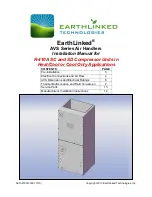
19
Air Handling Units
Active Carbon Filter Cartridge Check
There is no pressure loss change in the active carbon
filter cartridge due to fouling.
The most effective way to check the saturation of filter
cartridges is by weighing them. After reaching their maxi-
mum capacity, i.e. their net weight has increased by about
20% to 50 % (depending on the type of carbon and filtered
gas; ask the manufacturer for precise information), the
carbon cartridge must be reactivated. If this limit is excee-
ded, the filtering efficiency will be diminished. The total
weight of the clean standard, 450 mm long, active carbon
filter cartridge is 2,500 g, the weight of the filling is 2,000 g
(max. recommended increase in weight is 400 to 1,000 g).
The carbon cartridge is reactivated as a whole. It is
advisable to possess a spare set of filter cartridges.
Subsequent intervals of cartridge replacement can be
scheduled on the basis of the above-mentioned checking
measurements.
Checking the Exchangers (Heaters, Coolers)
Clean the dirty heat exchange surfaces using a vacuum
cleaner or hot-water cleaning machine.
Be very careful when cleaning the exchanger's vanes
to avoid mechanical damage.
It is important to check the air-venting of the exchan-
gers.
Permanently check the functionality of the condensate
draining system (coolers).
Important: If taking the exchanger out of operation
during the winter season, the water must be comple-
tely drained from the exchanger, and possible water
residuals must be removed, e.g. by blowing out the
exchanger with pressurised air; or the exchanger must
be filled with a safe antifreeze solution of water and
glycol.
Water residuals can freeze in the exchanger and
damage the copper pipes.
Operating Checks
Steam Generator Check
All prescribed checks are included in the Installation
Instructions attached to the steam generator. Please follow
these instructions, Especially in the first hours of operati
-
on: Check the water conductivity (min. 5 refills per water
exchange cycle, sparking and max. current checking);
check the cylinders for condition (water leakage) and ope-
ration; check the tightening of electrical connections.
Every three months of operation: Check the steam
generator operation (number of water refilling switchings
per cycle) and the condition of the cylinders (water leaka-
ge, condition of electrodes and inner casing of the cylin-
der).
Yearly or every 2500 service hours: Replace the boiling
cylinders; check the condition and shape of hoses; check
the sealing of the distributing tubes inside the chamber;
check the tightening of electrical connections
Warning: Electrical equipment! The steam genera-
tor cylinder can be hot. In case of water leakage, the
hazard of burning and/or electric shock exists! The
intervals of inspections and service life of parts can
vary depending on the water quality and operating
conditions.
Checking the Electric Heater
Check the heating coils for fouling; vacuum the heating
coils if necessary.
Check the functionality of the safety thermostats
Rotary Heat Exchanger Inspection
Rotary heat exchanger condition inspections must be
performed regularly; checking the rotor for cleanliness is
the most important part of these inspections. The user will
determine the intervals for regular inspections according
to the operating conditions, however, at least once every
3 months. At the same time, the user must perform the fo-
llowing checks:
Check the functionality.
Check the rotor for cleanliness.
Check the sealing brushes for tightness.
Check the rotor condition and tension of the driving
belt.
Check fouling of filters; inlet and outlet.
Connection tightness
If fouled or damaged, the filters must be replaced with
new ones immediately. If any fouling of the rotor is found,
the user must ensure its expert cleaning. The rotary heat
exchanger rotor can be cleaned by pressurized air, steam
or pressurized water. Failure to perform maintenance can
result in permanent damage to the rotary heat exchanger
rotor and very expensive repairs.
With divided rotors, the manufacturer recommends the
rotor perimeter casing be slightly tightened, including ad-
justment of the sealing elements, after 80 operating hours
(the tightening must be performed all along the perimeter
of the rotary heat exchanger so that it will not cause ovality
of the rotor).
Figure 33
– Sliding filtration wall handling

































